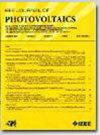Impedance Spectroscopy of Perovskite Solar Cells With SnO2 Embedding Graphene Nanoplatelets
IF 2.5
3区 工程技术
Q3 ENERGY & FUELS
引用次数: 0
Abstract
Characterizing the electron transport layer (ETL)/perovskite interface in perovskite solar cells (PSCs) is of paramount importance for their overall performance. In this article the effect of different concentrations of graphene nanoplatelets in addition to SnO2 is investigated by considering degradation over time. PSCs behavior is monitored by collecting dark current–voltage curves as fabricated and after two months. A deeper insight is gained through impedance spectroscopy analysis. From Nyquist plots equivalent circuit models and the corresponding time constants are extracted. Moreover, resistive part of the impedance associated with high frequency has been related to static shunt resistance, assessing one of the considered ETL doping concentration as the more suitable choice to reduce degradation.SnO2包埋石墨烯纳米片钙钛矿太阳能电池的阻抗谱研究
表征钙钛矿太阳能电池(PSC)中的电子传输层(ETL)/钙钛矿界面对其整体性能至关重要。在本文中,通过考虑随时间的降解,研究了除SnO2外不同浓度的石墨烯纳米片的影响。通过收集制造时和两个月后的暗电流-电压曲线来监测PSCs的行为。通过阻抗谱分析获得了更深入的见解。从奈奎斯特图中提取出等效电路模型和相应的时间常数。此外,与高频相关的阻抗的电阻部分与静态分流电阻有关,评估所考虑的ETL掺杂浓度之一是减少退化的更合适的选择。
本文章由计算机程序翻译,如有差异,请以英文原文为准。
求助全文
约1分钟内获得全文
求助全文
来源期刊

IEEE Journal of Photovoltaics
ENERGY & FUELS-MATERIALS SCIENCE, MULTIDISCIPLINARY
CiteScore
7.00
自引率
10.00%
发文量
206
期刊介绍:
The IEEE Journal of Photovoltaics is a peer-reviewed, archival publication reporting original and significant research results that advance the field of photovoltaics (PV). The PV field is diverse in its science base ranging from semiconductor and PV device physics to optics and the materials sciences. The journal publishes articles that connect this science base to PV science and technology. The intent is to publish original research results that are of primary interest to the photovoltaic specialist. The scope of the IEEE J. Photovoltaics incorporates: fundamentals and new concepts of PV conversion, including those based on nanostructured materials, low-dimensional physics, multiple charge generation, up/down converters, thermophotovoltaics, hot-carrier effects, plasmonics, metamorphic materials, luminescent concentrators, and rectennas; Si-based PV, including new cell designs, crystalline and non-crystalline Si, passivation, characterization and Si crystal growth; polycrystalline, amorphous and crystalline thin-film solar cell materials, including PV structures and solar cells based on II-VI, chalcopyrite, Si and other thin film absorbers; III-V PV materials, heterostructures, multijunction devices and concentrator PV; optics for light trapping, reflection control and concentration; organic PV including polymer, hybrid and dye sensitized solar cells; space PV including cell materials and PV devices, defects and reliability, environmental effects and protective materials; PV modeling and characterization methods; and other aspects of PV, including modules, power conditioning, inverters, balance-of-systems components, monitoring, analyses and simulations, and supporting PV module standards and measurements. Tutorial and review papers on these subjects are also published and occasionally special issues are published to treat particular areas in more depth and breadth.
 求助内容:
求助内容: 应助结果提醒方式:
应助结果提醒方式:


